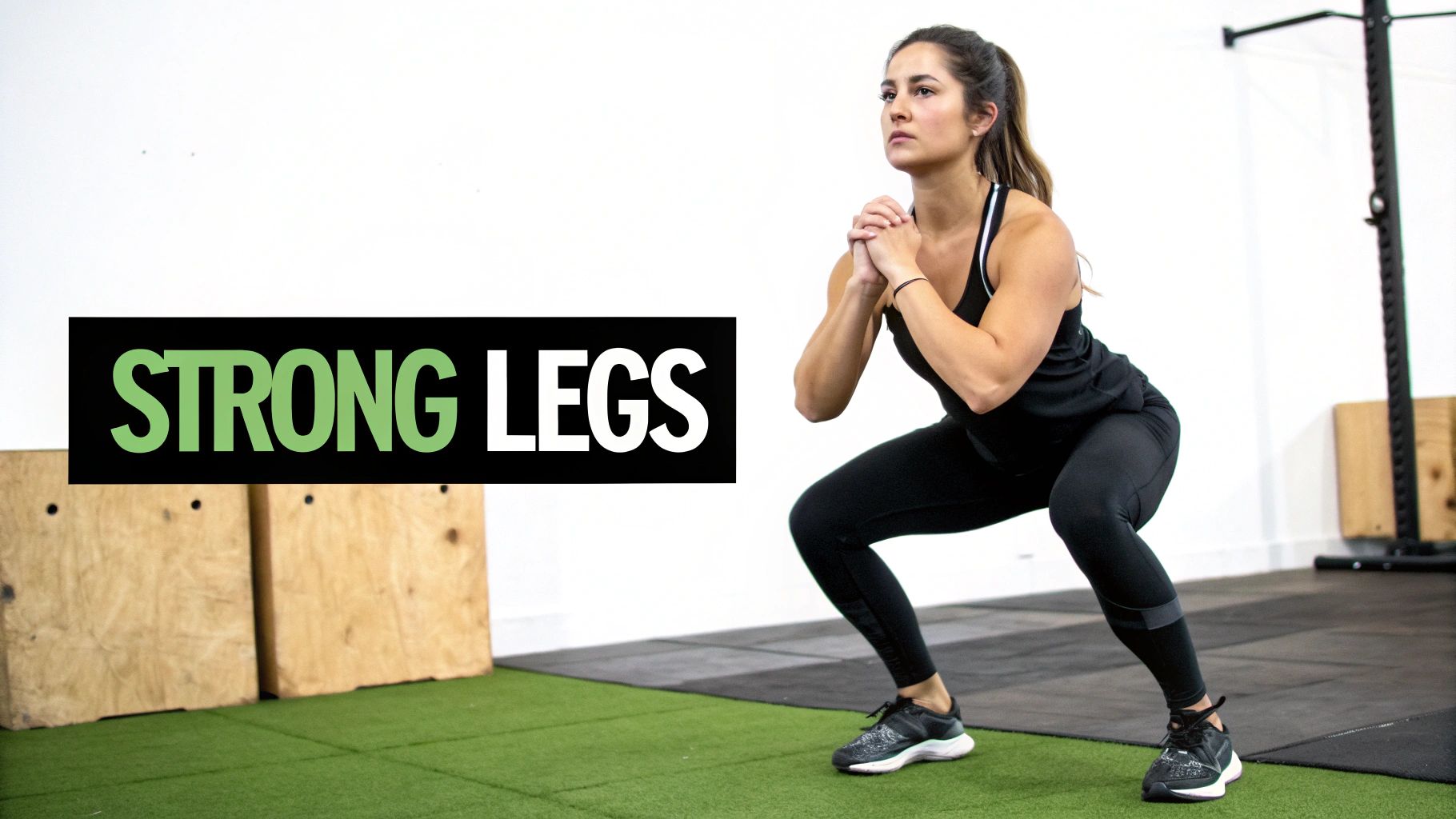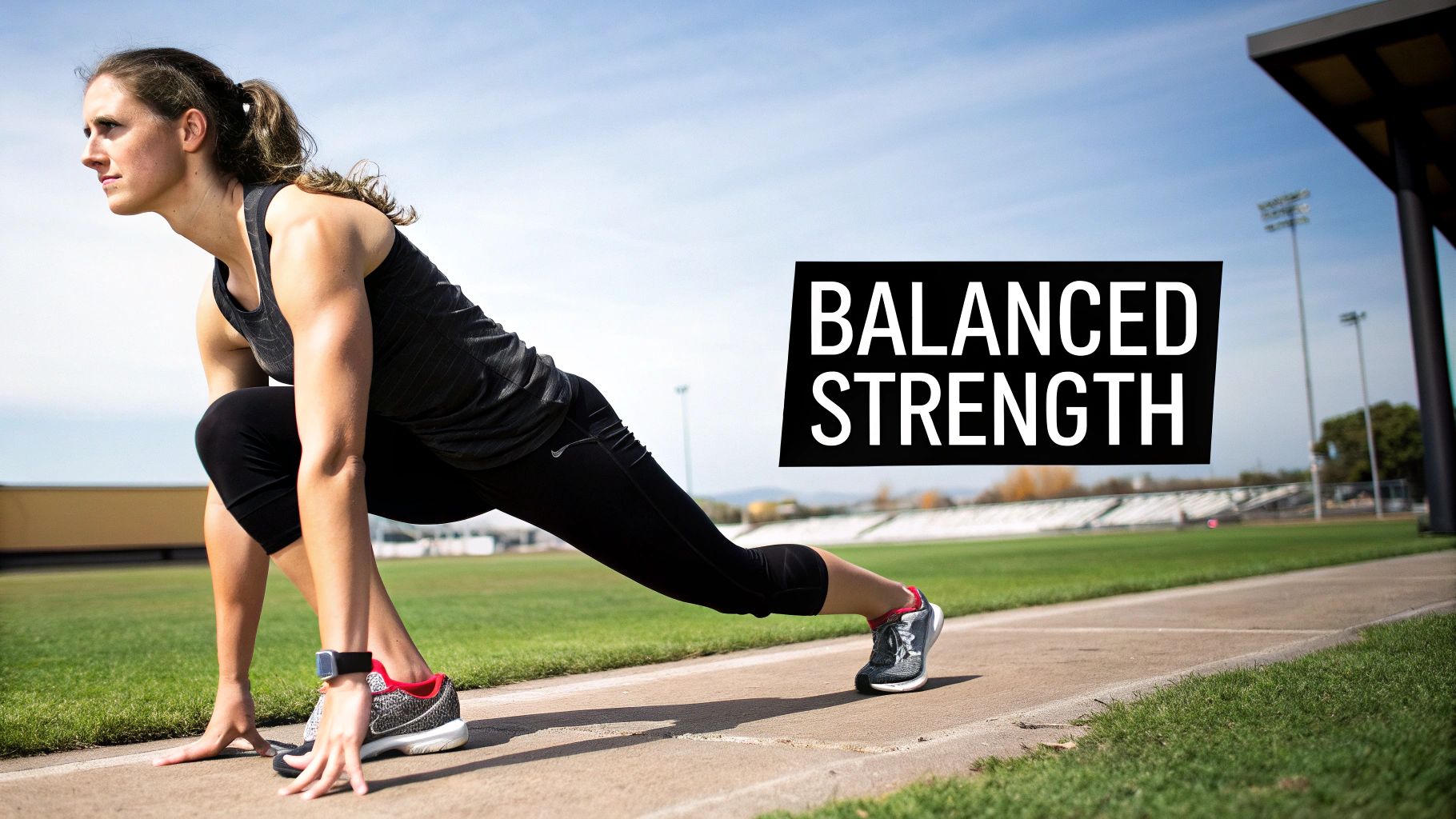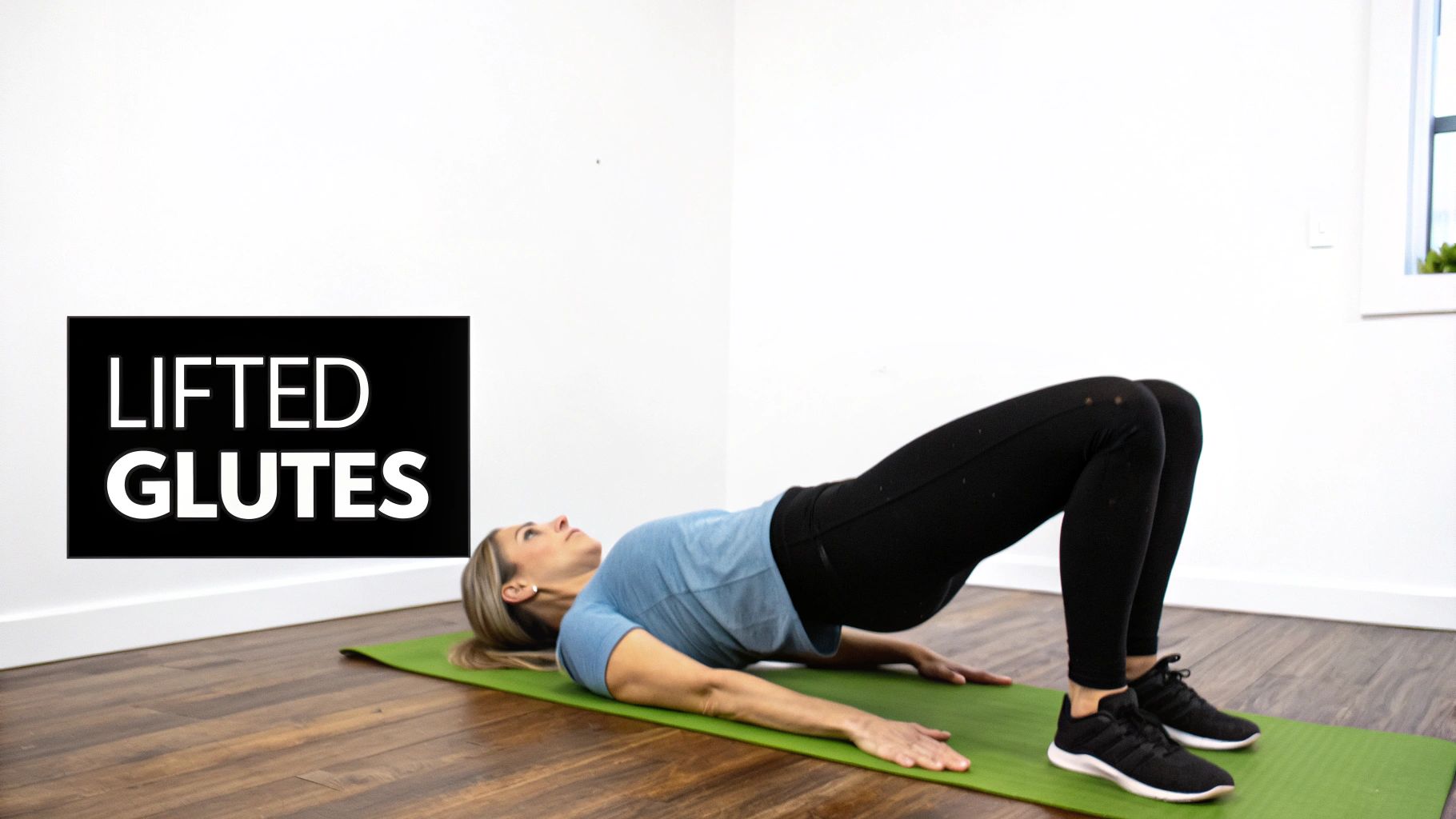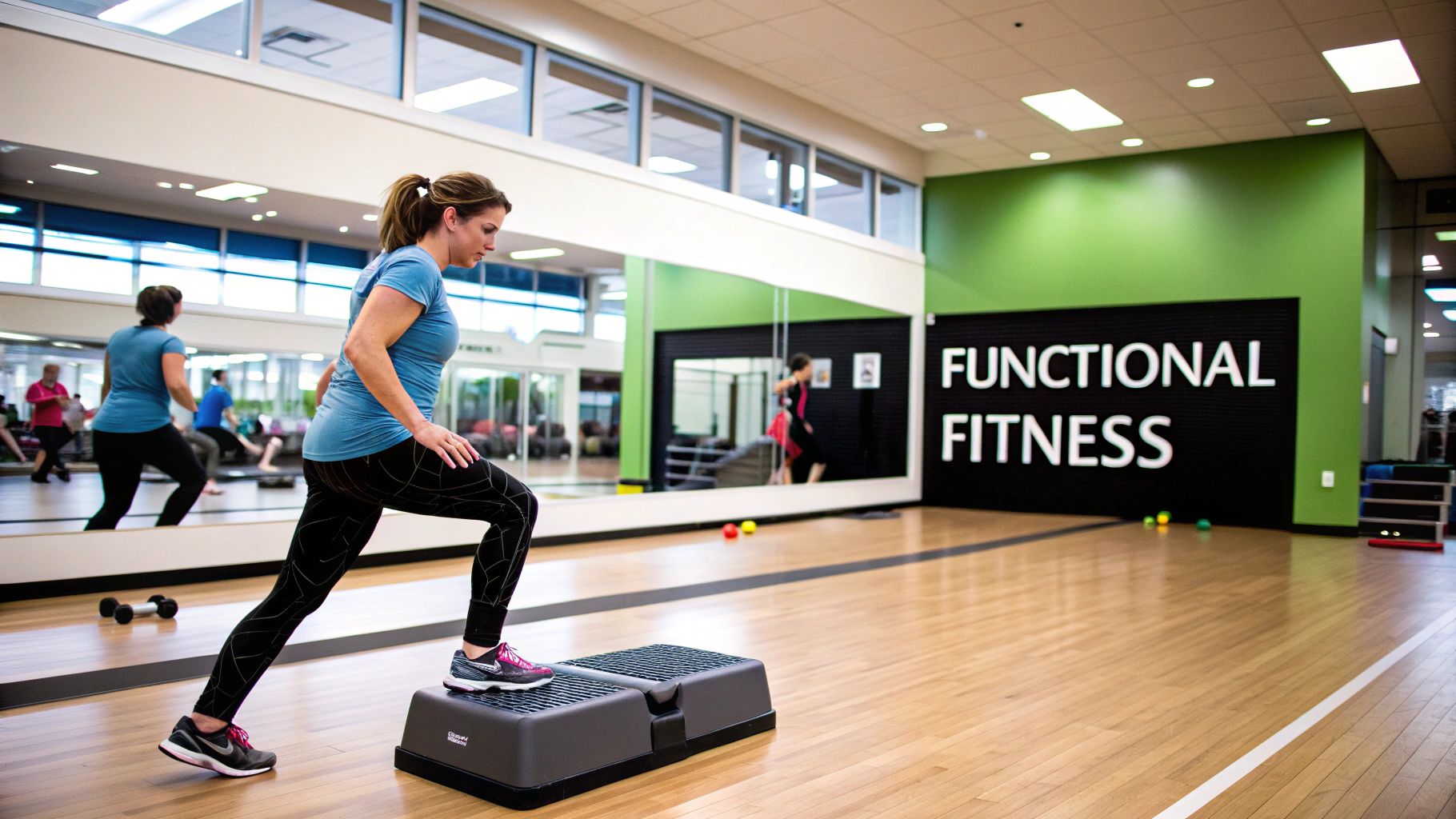
Top Leg Toning Exercises for Women to Sculpt Strong Legs
Share
Are you ready to build strong, toned legs that not only look incredible but also power you through your day with confidence and strength? The journey to sculpted legs goes beyond endless cardio sessions; it's about strategic, targeted strength training that builds lean muscle. This guide is your definitive resource, breaking down the most essential leg toning exercises for women. We move past generic advice to provide actionable steps, crucial form corrections, and smart ways to integrate these movements into a powerful and effective routine.
Forget guesswork and wasted effort. We will explore the biomechanics behind each movement, ensuring every squat, lunge, and deadlift directly contributes to your specific goals. You will learn not just what to do, but why it works, giving you the knowledge to train more intelligently.
Whether you're a beginner laying a solid foundation or an experienced lifter seeking to break through a plateau and achieve new levels of definition, these exercises are your blueprint. This list provides the exact tools you need to build the strong, toned, and functional legs you’ve been working towards. Let’s dive in and start sculpting.
1. Squats
The squat is often hailed as the king of lower body movements, and for good reason. This foundational compound exercise is a powerhouse for developing strength and tone in your legs. It simultaneously engages multiple major muscle groups, including the quadriceps (front of thighs), hamstrings (back of thighs), glutes (buttocks), and calves. The movement pattern mimics the natural action of sitting down and standing up, making it a functional exercise that improves everyday strength.

Because it recruits so much muscle mass, the squat is not just one of the best leg toning exercises for women; it's also highly effective for boosting metabolism and burning calories. Its versatility allows for endless variations, making it suitable for everyone from beginners to elite athletes.
Mastering the Form
Proper form is crucial to maximize benefits and prevent injury. Focus on these key points to execute a perfect squat:
- Posture: Stand with your feet shoulder-width apart, toes pointing slightly outward. Keep your chest lifted and your back straight, engaging your core muscles to stabilize your spine.
- Movement: Initiate the squat by pushing your hips back and down, as if sitting in an invisible chair. Lower yourself until your thighs are at least parallel to the floor, ensuring your knees track in line with your toes and do not cave inward.
- Power: Drive through your heels to return to the starting position, squeezing your glutes at the top of the movement.
When to Incorporate Squats
Squats should be a cornerstone of any leg-focused workout routine. For a comprehensive approach to sculpting your lower body, explore how squats fit into a broader strategy. You can learn more about how to tone legs fast and see how this exercise complements other movements. Incorporate them at the beginning of your leg day when your muscles are fresh to handle heavier loads or more volume. You can also integrate bodyweight squats into a full-body circuit or as a warm-up. Start with 3 sets of 12-15 repetitions, focusing on form before adding resistance like dumbbells or a barbell.
2. Lunges
Lunges are a fundamental unilateral exercise, meaning they work each leg independently. This powerful movement involves stepping into a split stance and lowering your body, targeting the quadriceps, hamstrings, glutes, and calves with precision. By isolating one leg at a time, lunges are exceptionally effective at identifying and correcting muscle imbalances between your left and right sides, leading to more symmetrical and sculpted legs.

Beyond toning, this exercise significantly improves balance, coordination, and hip flexibility, making it a functional movement that enhances everyday activities. Its versatility and effectiveness have made it a staple in numerous fitness programs, from Jillian Michaels' intense workouts to the targeted routines in Anna Victoria's Fit Body Guides. Lunges are a go-to for anyone seeking lean, strong legs.
Mastering the Form
Correct lunge form protects your joints, especially your knees, while ensuring the right muscles are engaged. Concentrate on these essential details:
- Posture: Begin by standing tall with your feet together. Engage your core to keep your torso upright and stable throughout the entire movement.
- Movement: Step one foot forward or backward, planting it firmly on the ground. Lower your hips until both knees are bent at a 90-degree angle. Your front knee should be directly above your ankle, and your back knee should hover just above the floor.
- Power: Push off with the heel of your front foot to drive yourself back to the starting position. Control the movement on the way up and down, avoiding any bouncing.
When to Incorporate Lunges
Lunges are incredibly versatile and can be programmed into your routine in several ways. They work well following a heavy compound lift like squats or can serve as the primary strength movement for the day. For those looking for a dynamic challenge, walking lunges add a cardiovascular component that elevates the heart rate.
As one of the most effective leg toning exercises for women, lunges can be modified for any fitness level. Start with bodyweight reverse lunges if you have knee sensitivity, as they are often more joint-friendly. Aim for 3 sets of 10-12 repetitions on each leg, focusing on perfect form before adding dumbbells for increased resistance.
3. Glute Bridges
The glute bridge is a fantastic floor-based movement that isolates the posterior chain. This exercise primarily targets the gluteal muscles and hamstrings, making it a cornerstone for anyone looking to build a stronger, more toned backside. Because it's performed lying on your back, it places minimal stress on the spine and knees, making it an accessible and safe choice for all fitness levels, including those in prenatal or postnatal fitness programs.

Popularized by experts like Bret Contreras, "The Glute Guy," this exercise is celebrated for its ability to activate the glutes effectively. It serves as an excellent activation drill before heavier lifts or as a primary strengthening movement, solidifying its spot as one of the most effective leg toning exercises for women seeking targeted results.
Mastering the Form
Perfecting the glute bridge is all about mind-muscle connection. Concentrate on these details to get the most out of every repetition:
- Setup: Lie on your back with your knees bent and feet flat on the floor, about hip-width apart and close enough that you can touch your heels with your fingertips. Rest your arms by your sides.
- Movement: Press firmly through your heels to lift your hips off the floor until your body forms a straight line from your shoulders to your knees. Squeeze your glutes powerfully at the top; avoid over-arching your lower back.
- Control: Hold the peak contraction for a second or two before slowly lowering your hips back to the starting position with control.
When to Incorporate Glute Bridges
Glute bridges are incredibly versatile. You can use them as part of your warm-up to "wake up" your glutes before a squat or deadlift session, ensuring they fire correctly during more complex movements. They also work perfectly as a burnout exercise at the end of your workout to fully fatigue the muscle. To understand the mechanics of glute development further, you can get more details on how to build glutes and see where this exercise fits into a complete program. Aim for 3 sets of 15-20 repetitions, focusing on a strong squeeze at the top. To increase the challenge, place a dumbbell across your hips or progress to a single-leg variation.
4. Step-Ups
Step-ups are a fundamental and highly effective exercise for building lower body strength and creating toned, sculpted legs. This movement involves stepping onto an elevated platform, like a bench or box, using the power of one leg to lift your entire body. It masterfully targets the quadriceps, hamstrings, and glutes, with a particular emphasis on the gluteus maximus and quad of the leading leg. Its unilateral nature forces each leg to work independently, correcting strength imbalances and enhancing stability.

This functional exercise mimics everyday actions like climbing stairs, making it practical for improving real-world strength. Because it challenges balance and coordination, it also engages your core for stabilization, making it more than just a leg exercise. The simplicity and accessibility of step-ups have made them a staple in popular fitness programs like Barry's Bootcamp and those created by trainers like Autumn Calabrese.
Mastering the Form
Proper execution is key to engaging the right muscles and preventing strain. Concentrate on these points for a perfect step-up:
- Platform and Posture: Choose a stable platform (bench, box, or step) where your knee forms a 90-degree angle when your foot is placed on it. Stand tall with your chest up and core engaged.
- Movement: Place one full foot firmly onto the platform. Drive through the heel of that elevated foot to lift your body up until your leg is straight. Avoid pushing off forcefully with the foot on the ground; let the working leg do all the lifting.
- Control: Step back down with the same foot in a slow, controlled manner to complete the repetition. Maintain your balance throughout the entire movement.
When to Incorporate Step-Ups
Step-ups are a versatile addition to any routine focused on leg toning exercises for women. They can be performed with just bodyweight for a great warm-up or as part of a high-intensity circuit. To increase the challenge and promote muscle growth, hold dumbbells in each hand. Incorporate them into your leg day after major compound lifts like squats or deadlifts. Aim for 3 sets of 12-15 repetitions per leg, ensuring you complete all reps on one side before switching to the other.
5. Deadlifts (Romanian Deadlifts)
While squats are king for the front of the legs, the Romanian Deadlift (RDL) is the queen for the posterior chain. This essential hip-hinge movement is a superstar for developing strength and definition in the hamstrings, glutes, and lower back. By focusing on pushing the hips back rather than squatting down, the RDL isolates the muscles on the back of your legs, creating a long, sculpted, and lifted look.
The RDL is one of the most effective leg toning exercises for women precisely because it targets areas that are often underdeveloped. A strong posterior chain not only contributes to a well-rounded physique but also improves posture and reduces the risk of injury. It's a staple in programs designed by experts like Bret Contreras and is frequently used in bikini competition prep for its powerful glute-shaping benefits.
Mastering the Form
Proper RDL form is all about the hip hinge. The movement should come from your hips, not your lower back, to maximize hamstring and glute engagement.
- Starting Position: Stand with your feet hip-width apart, holding dumbbells or a barbell in front of your thighs. Maintain a slight bend in your knees throughout the entire movement.
- The Hinge: Keeping your back perfectly straight and chest up, initiate the movement by pushing your hips backward as if trying to touch a wall behind you. Allow the weights to slide down the front of your legs, keeping them close to your body.
- The Stretch: Lower the weight until you feel a deep stretch in your hamstrings, typically to about mid-shin level. Do not round your lower back to go lower.
- The Return: Drive your hips forward to return to the standing position, squeezing your glutes powerfully at the top.
When to Incorporate Deadlifts
Romanian Deadlifts are best performed on leg day, often after your primary compound lifts like squats. Since they heavily tax the hamstrings and glutes, doing them while you are still relatively fresh ensures you can maintain good form. They are crucial for anyone wanting to build lean muscle and achieve a balanced lower body. For more insight into this process, you can explore how to build lean muscle for women. Start with light dumbbells and focus on the mind-muscle connection, aiming for 3 sets of 10-12 repetitions.
6. Leg Press
The leg press is a fantastic machine-based exercise that allows you to safely load your lower body with significant weight. By providing back support and a fixed movement path, it removes the stability and balance challenges associated with free-weight exercises like squats. This makes it an excellent choice for isolating the quadriceps, hamstrings, and glutes, allowing for focused muscle development. It's one of the most effective leg toning exercises for women seeking to build strength and add shape to their legs in a controlled environment.
This exercise is a staple in bodybuilding routines and commercial gym programs precisely because it allows you to push your leg muscles to their limit with a lower risk of form breakdown. The machine’s design helps you concentrate purely on the pressing motion, which is ideal for hypertrophy (muscle growth) and achieving that toned, sculpted look.
Mastering the Form
Proper technique on the leg press is key to targeting the right muscles and preventing strain on your lower back and knees.
- Positioning: Sit on the machine with your back and head flat against the padded support. Place your feet on the platform about hip-width apart. Your feet should be flat.
- Movement: Release the safety bars and press the platform up until your legs are nearly extended, but do not lock your knees. Slowly lower the platform until your knees form a 90-degree angle, ensuring your lower back stays firmly against the seat.
- Power: Drive the platform back up by pushing through your heels, focusing on using your quads and glutes. Avoid letting your hips or lower back lift off the seat as you lower the weight.
When to Incorporate the Leg Press
The leg press is a versatile exercise that can be used to build mass or improve muscular endurance. It works well as a primary compound movement after squats, or as the main heavy lift if you have limitations preventing you from squatting. A higher foot placement on the platform will target the glutes and hamstrings more, while a lower placement emphasizes the quadriceps. Aim for 3 sets of 12-15 repetitions with a weight that challenges you by the final reps.
7. Calf Raises
While often overlooked in favor of thigh and glute exercises, calf raises are essential for creating balanced, sculpted, and powerful lower legs. This isolation movement specifically targets the gastrocnemius and soleus muscles, the two primary muscles that make up the calf. Developing these muscles adds shapely definition to the lower leg, contributing to a comprehensively toned appearance from hip to ankle.
This exercise is fundamental in everything from ballet and dance conditioning to strength programs for runners, as strong calves improve ankle stability, power, and jumping ability. As one of the most direct leg toning exercises for women, calf raises are simple to perform yet incredibly effective for building that coveted lower leg curve. Their versatility allows them to be done anywhere, with or without equipment.
Mastering the Form
Proper form ensures you are targeting the calf muscles effectively and avoiding strain on the ankle or Achilles tendon.
- Posture: Stand with your feet hip-width apart, either on a flat surface or with the balls of your feet on an elevated edge like a step or stair. Keep your core engaged and your body upright.
- Movement: Slowly press through the balls of your feet to raise your heels as high as you can. Pause at the top to fully contract the calf muscles.
- Control: Lower your heels back down with control, going below the level of the step if you are on an elevated surface to get a good stretch.
When to Incorporate Calf Raises
Calf raises are an excellent finishing exercise for your leg day workout, after your main compound lifts like squats and lunges. You can also incorporate them into a full-body circuit or perform them on their own on an active recovery day. Due to the high endurance nature of calf muscles, they respond well to higher repetitions. Start with 3 sets of 15-20 repetitions. To increase the challenge, hold dumbbells, use a calf raise machine, or perform the exercise one leg at a time.
8. Side Leg Lifts (Lateral Leg Raises)
Side leg lifts, also known as lateral leg raises, are a classic isolation exercise that specifically targets the muscles on the outside of your hips and thighs. This movement focuses on the hip abductors, primarily the gluteus medius and minimus. These smaller glute muscles are essential for hip stability and are key to sculpting a rounded, lifted booty and toned outer thighs.

Popularized in the iconic workout videos of the 80s and still a staple in modern Pilates, barre, and prenatal fitness programs, this exercise is one of the most effective leg toning exercises for women seeking to shape the often-overlooked outer hip area. Its low-impact nature makes it accessible for all fitness levels, yet it delivers a significant burn when performed correctly.
Mastering the Form
Proper form is vital for effectively isolating the target muscles and avoiding strain on your lower back. Concentrate on these key points for perfect execution:
- Alignment: Lie on your side with your legs extended and stacked. Your body should form a straight line from your head to your heels. Engage your core to prevent your torso from rocking.
- Movement: Slowly lift your top leg towards the ceiling without using momentum. Raise it only as high as you can while keeping your hips stacked and still. Pointing your toes slightly downward can deepen the engagement in your outer thigh.
- Control: Lower the leg back down with the same slow, controlled motion. Avoid letting it just drop. The resistance on the way down is just as important as the lift.
When to Incorporate Side Leg Lifts
Side leg lifts are perfect as a targeted finisher at the end of your leg day to completely exhaust the hip abductors. They can also be included in a glute activation warm-up series to "wake up" the muscles before performing compound movements like squats and lunges. Because they require no equipment, they are also an excellent addition to at-home workouts or full-body circuits. Aim for 3 sets of 15-20 repetitions per side, focusing on slow, controlled movements and feeling the muscle burn.
Leg Toning Exercise Comparison Matrix
| Exercise | Implementation Complexity 🔄 | Resource Requirements ⚡ | Expected Outcomes 📊 | Ideal Use Cases 💡 | Key Advantages ⭐ |
|---|---|---|---|---|---|
| Squats | Moderate 🔄 | None to moderate (bodyweight/resistance) ⚡ | Full leg and core strength, calorie burn 📊 | Leg toning, strength building, metabolic boost 💡 | Multi-muscle engagement, improves mobility ⭐ |
| Lunges | Moderate 🔄 | Minimal (space, optional weights) ⚡ | Corrects muscle imbalance, balance improvement 📊 | Sculpting legs, functional fitness, rehab 💡 | Unilateral focus, enhances coordination ⭐ |
| Glute Bridges | Low 🔄 | None or light resistance ⚡ | Glute activation, hip strength, low joint stress 📊 | Glute toning, rehab, beginners 💡 | Knee-friendly, easy to perform ⭐ |
| Step-Ups | Moderate 🔄 | Elevated platform, optional weights ⚡ | Functional leg strength, balance 📊 | Everyday activity simulation, cardio-strength combo 💡 | Adjustable difficulty, functional benefits ⭐ |
| Romanian Deadlifts | High 🔄 | Weights (dumbbells/barbells) ⚡ | Hamstring and glute toning, posture improvement 📊 | Advanced toning, strength, athletic performance 💡 | Posterior chain focus, improves flexibility ⭐ |
| Leg Press | Low to Moderate 🔄 | Leg press machine required ⚡ | Heavy leg loading, muscle tone 📊 | Strength building without balance demand 💡 | Safe heavy lifting, isolates leg muscles ⭐ |
| Calf Raises | Low 🔄 | None or optional weights ⚡ | Calf definition, ankle strength 📊 | Calf toning, ankle stability, convenience 💡 | Can be performed anywhere, simple ⭐ |
| Side Leg Lifts | Low 🔄 | None or optional bands/weights ⚡ | Outer thigh/hip toning, hip stability 📊 | Hip strengthening, outer thigh shaping 💡 | Targets neglected muscles, improves balance ⭐ |
Putting It All Together: Your Path to Stronger Legs
You now possess a comprehensive and powerful toolkit of the most effective leg toning exercises for women. Moving beyond simply knowing the names of movements like squats, lunges, and deadlifts, you understand the nuances of form, the importance of variations, and how to integrate each exercise for maximum impact. This article was designed not just to give you a list, but to provide a strategic blueprint for sculpting strong, defined, and powerful legs from every angle.
The journey from knowledge to results, however, is paved with consistent and intelligent action. The true secret to transformation isn't found in a single workout or a magical exercise. Instead, it lies in the dedicated application of core principles week after week.
Key Takeaways for Building Your Best Legs
To truly harness the power of this guide, let's distill the most critical takeaways that will serve as your foundation for progress:
- Form Over Everything: Before adding a single pound of weight, your absolute priority must be mastering proper form. An incorrect squat pattern not only increases injury risk but also fails to activate the intended muscles, sabotaging your results.
- Mind-Muscle Connection is Real: Actively thinking about the muscle you are working, whether it's the glutes during a bridge or the hamstrings during a Romanian Deadlift, creates stronger neural pathways. This intentional focus leads to better muscle fiber recruitment and significantly more effective workouts.
- Progressive Overload is Non-Negotiable: To build lean, toned muscle, you must consistently challenge your body. This doesn't always mean lifting heavier. It can also mean adding more reps, increasing sets, reducing rest time, or improving your form. Your body adapts quickly, so you must continually give it a new reason to change.
Your Actionable Next Steps
Information is only potential power; action is where the real change happens. Here’s how to put this guide into practice starting today:
- Build Your Foundation: Select 3-4 exercises from this list to create two distinct lower-body workouts for the week. For example, one day could focus on quad-dominant movements like Squats and Step-Ups, while the other targets the posterior chain with Deadlifts and Glute Bridges.
- Schedule and Commit: Treat your workouts like important appointments. Block them out in your calendar. Consistency is your single greatest ally in achieving the toned legs you desire. Missing a workout here and there is human, but a consistent pattern of showing up is what builds momentum and delivers results.
- Listen to Your Body: Recognize the difference between the discomfort of a challenging workout and genuine pain. Muscle soreness is a sign of adaptation, but sharp, persistent pain is a signal to stop. Prioritize rest, recovery, and proper mobility work to support your training and prevent setbacks.
Mastering these leg toning exercises for women is about so much more than aesthetics. It’s about building a body that is resilient, powerful, and capable. It’s about the confidence that comes from seeing your strength increase and the empowerment of knowing you built that strength yourself. Every rep, every set, and every workout is an investment in your physical and mental well-being.
Ready to amplify your hard work and see results faster? Complement your dedication in the gym with targeted nutritional support. The clean creatine formula from Bold Buns is specifically designed for women to enhance strength, support lean muscle growth, and improve workout performance without the common side effects of bloating. Give your muscles the fuel they need to recover and grow stronger by visiting Bold Buns.
